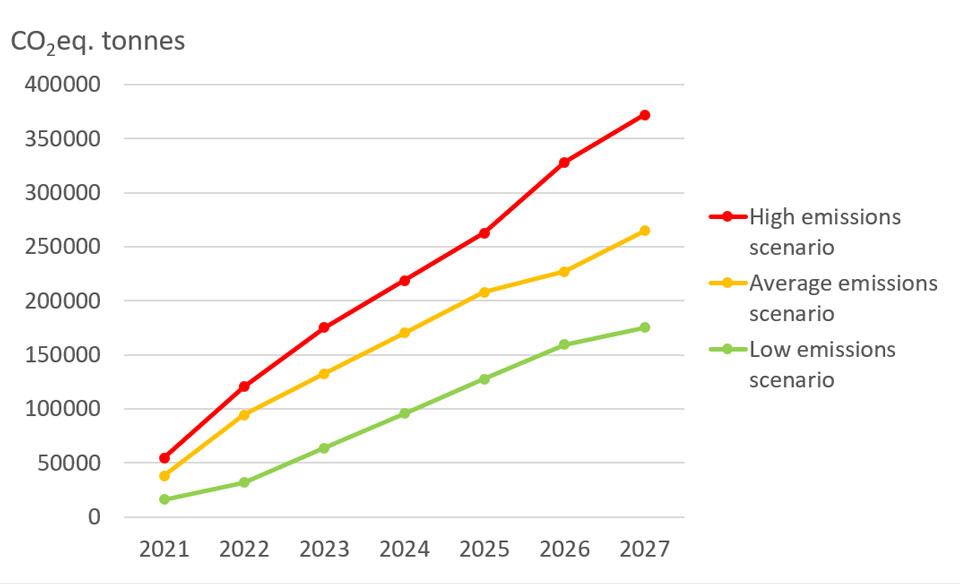
Sirpa Kokko
Mobility of students and staff as well as transnational cooperation of Higher Education Institutions (HEIs) increased after a rapid decline due to COVID-19 pandemic. Mobility increases also due to increased opportunity. The budget of the Erasmus+ program 2021–2027 has nearly doubled compared to the budget of the predecessor program 2014–2020 (European Commission, 2021). Increased mobility results in an increased carbon footprint. Three-scenario-forecast of the transport-related carbon footprint of the program 2021–2027 (Fig. 1) shows that carbon footprint will increase significantly in all three scenarios (Kokko & Saarela, 2021a), unless actions are not taken.

Total emissions of each scenario increase over time. For the program 2021–2027, total emissions of the high emissions scenario are 1,503,646 tonnes CO2eq., total emissions of the average emissions scenario 1,133,654 tonnes CO2eq. and total emissions of the low emissions scenario 668,750 tonnes CO2eq. (Kokko & Saarela, 2021a). Similar results of the increase of emissions were obtained in the study by the Finnish National Agency for Education (Finnish National Agency for Education, 2021a).
Erasmus+ program
Erasmus+ program is one of the biggest contributors to mobility and transnational cooperation in Europe. For instance, in Finland, over a period of more than 30 years, more than 90 000 Finnish higher education students have completed a student exchange and 13 000 students a traineeship. 120 000 incoming higher education students have participated Erasmus+ program in Finland in 30 years. About 2 000 staff members of Finnish higher education institutions participate in Erasmus+ program every year. (Finnish National Agency for Education, 2021b; Kokko & Saarela, 2021b)
The Erasmus+ program has taken actions, based on the European Green Deal, towards carbon-neutrality in mobility as well as actions in fighting against global warming. The program has defined environmental sustainability as one of its priorities for the 2021–2027 period. Therefore, the program promotes sustainable transport modes and more environmentally responsible behavior, e.g. by giving financial support to choose green modes of transport and supporting short-term and blended mobilities. The program also prioritizes projects that enable behavioral changes for individual preferences, and supports active engagement for sustainable development. (European Commission, 2022, 9)
Guidelines to make mobility and transnational cooperation green
Erasmus Goes Green project (Erasmus Goes Green, 2022a) has made recommendations for actions, that promote making mobility of students and staff and transnational cooperation between HEIs green and sustainable. The recommended actions are in line with the aims of the Erasmus+ program. The actions are in three guidelines: Higher Education student’s handbook to travel green, Guidelines for Higher Education Institutions towards more sustainable cooperation and Policy recommendations.
Higher Education student’s handbook to travel green helps students to make greener choices when travelling to and from mobility destinations. The handbook includes the overall travel habits of students, the impacts of Erasmus+ mobility on the environment, explanations of importance of choosing sustainable transport options and concrete tips on how to plan sustainable journeys. There are also travel stories from students how to travel to and from mobility destination sustainably in the handbook. (Alves & Di Marzo, 2022)
Guidelines for Higher Education Institutions provide an overview of actions to make transnational cooperation more environmentally sustainable, targeted at HEIs leadership, staff members and Erasmus+ coordinators. (Terzieva & Alves, 2022)
Policy recommendations are targeted at policy-makers in charge of the management of the Erasmus+ program (e.g. Erasmus+ National Agencies) and decision-makers in HEIs, student associations and Ministries of Education. Recommendations provide an action framework to transform the Erasmus+ mobility activities into more environmentally friendly practices. The document aims for all target groups to join forces to foster a transformation into a greener Erasmus+. (Alves & Terzieva, 2022)
Actions to make mobility and transnational cooperation green
Actions, primarily from the above-mentioned guidelines (Alves & Di Marzo, 2022; Alves & Terzieva, 2022; Terzieva & Alves, 2022), to make mobility and transnational cooperation green are described for higher education students, HEIs and decision-makers in HEIs.
Actions for students to travel green are to
- calculate environmental impacts of considered transport options by using a CO2 calculator, such as the CO2 visualization tool (Erasmus Goes Green, 2022b) created within the Erasmus Goes Green project
- choose the most sustainable mode of transport available for the journey
- offset emissions that cannot be avoided on the journey
Options for offsetting are e.g. planting trees, carbon capture and projects to enhance food waste management. It has to be remembered that offsetting is always the last option to reduce emissions. Avoiding emissions comes first. (de Pater et al., 2022)
Actions for staff members participating in transnational partnerships are to
- use more sustainable means of transport
- avoid unnecessary journeys and make a better use of time
- modify partnership documents to mention the environmental responsibility of the partners
Actions for HEIs leadership are to
- set targets for reducing HEIs travel emissions
- keep record of the Erasmus+ mobility travel details
- encourage staff to improve their transnational partnerships’ carbon efficiency, that include combining multiple meetings in a single trip, advocate for more sustainable means of transport and promoting alternatives to travel
- create an implementation and monitoring plan, thus, identify the key performance indicators (KPIs) for monitoring the performance against objectives and targets
Actions for Erasmus+ coordinators are to
- raise awareness among Erasmus+ students on sustainable travelling
- provide guided travel planning to students
- provide easy access to complementary travel products and services
- promote the usage of the CO2 calculator
Actions for decision makers in HEIs are to
- create an institutional Erasmus+ sustainable travelling strategy
- assess the actual carbon footprint of the HEI
- improve the support to students and staff to promote behavioral change
An institutional sustainable travelling strategy consists of implementing air travel policy, training and recruiting staff for sustainability roles, changing of institutional culture of sustainable travel choices and strengthening the position of students as active agents in promoting sustainability. Assessment of actual carbon footprint of HEI gives information of carbon footprint of HEI to identify the most urgent areas to tackle. Comparing result of the assessment to European targets and other HEIs gives information where to improve. Promoting behavioral change of students and staff towards sustainable travel are e.g. communication and campaigns showing how to travel sustainably, facilitating group travel by linking up travelers going to the same destination, promoting the journey as an experience itself, and implementation of monetary compensation to stimulate sustainable travel. (Alves & Terzieva, 2022) Financial incentives can be partial or full compensation of direct costs of sustainable travel (e.g. upfront top-ups and reimbursements) or compensations of complementary products and services that improve convenience of sustainable travel (e.g. discounts and travel cards) (de Pater et al., 2022).
Conclusions
By taking actions, students and staff can reduce the transport-related carbon footprint, thus, lower the impact of their mobility to the environment. Besides change of travelling habits of individuals, a more structured change is needed to achieve environmentally sustainable mobility of people. Structured change includes e.g. improvement of connections of trains and busses in Europe as well as improvement of ticket sale (Alves & Di Marzo, 2022). Tickets to ground transportation should be available for the entire trip similarly as air plane tickets.
The actions targeted at HEIs complement the actions of the commitment of all the universities of applied sciences in Finland (Arene, 2020) towards carbon neutrality. The action of creating a framework for a sustainable mobility strategy will help reducing the transport-related carbon footprint of a HEI in the long run.
Erasmus Goes Green project
Erasmus Goes Green project (Erasmus Goes Green, 2022a) aimed at lowering impact the Erasmus+ program has on the environment. Main objective was to find solutions to reduce the transport-related carbon footprint of higher education students and staff taking part in Erasmus mobility.
There were seven partner organizations in the project: Université de Versailles Saint-Quentin-en-Yvelines (France), Lapland University of Applied Sciences (Finland), Aristotle University of Thessaloniki (Greece), University of Lodz (Poland), Erasmus University Rotterdam (the Netherlands), Erasmus Student Network (Belgium) and the European University Foundation (Luxembourg).
Sirpa Kokko, M.Sc. (Tech.), specialist, Lapland University of Applied Sciences, sirpa.kokko(at)lapinamk.fi
References
Alves, H. & Di Marzo, P. (2022). A sustainable journey for a sustainable Erasmus – Higher Education student’s handbook to travel green. Available 27.10.2022. https://www.egg-project-eu.uvsq.fr/policy-recommendations-and-guidelines
Alves, H. & Terzieva, V. (2022). Policy recommendations. European University Foundation. Available 17.11.2022. https://www.egg-project-eu.uvsq.fr/policy-recommendations-and-guidelines
Arene. (2020). Sustainable, responsible and carbon-neutral universities of applied sciences – Programme for the sustainable development and responsibility of universities of applied sciences. Available 18.11.2022. https://www.arene.fi/wp-content/uploads/Raportit/2020/Sustainable%2C%20responsible%20and%20carbon-neutral%20universities%20of%20applied%20sciences.pdf
de Pater, M., Gabrielczak, P., Kokko, S., Omar, M. & Saarela, H. (2022). Measures to reduce the transport-related carbon footprint of the Erasmus+ programme. Available 27.10.2022. https://www.egg-project-eu.uvsq.fr/incentives-and-carbon-offsetting-for-erasmus
Erasmus Goes Green. (2022a). Overview of the project. Available 1.12.2022. https://www.egg-project-eu.uvsq.fr/overview-of-the-project
Erasmus Goes Green. (2022b). What is the carbon footprint of your choice of travel? Available 1.12.2022. https://egg.civil.auth.gr/#calculator
European Commission. (2021). European Commission, Directorate-General for Education, Youth, Sport and Culture. Erasmus+ 2021-2027: enriching lives, opening minds through the EU programme for education, training, youth and sport. Publications Office. Available 17.10.2022. https://op.europa.eu/en/publication-detail/-/publication/ff1edfdf-8bca-11eb-b85c-01aa75ed71a1/language-en
European Commission. (2022). Erasmus+ Programme Guide. Version 2. Available 17.10.2022. https://erasmus-plus.ec.europa.eu/sites/default/files/2022-01/2022-erasmusplus-programme-guide-v2_en_0.pdf
Finnish National Agency for Education. (2021a). Feasibility study on compensation scenarios for the new and greener Erasmus+ programme 2021–2027. 119 p. https://www.oph.fi/en/statistics-and-publications/publications/feasibility-study-compensation-scenarios-new-and-greener
Finnish National Agency for Education. (2021b). What is Erasmus+ for higher education in 2021–2027? Available 17.10.2022. https://www.oph.fi/en/programmes/what-erasmus-higher-education-2021-2027
Kokko, S. & Saarela, H. (2021a). The carbon footprint of the Erasmus+ programme 2021–2027. In the Assessment of the transport-related carbon footprint of the Erasmus+ programme, p. 106-121. Available 27.10.2022. https://www.egg-project-eu.uvsq.fr/erasmus-what-carbon-footprint
Kokko, S. & Saarela, H. (2021b). Erasmus goes green. Lumen Lapland UAS Journal 3/2021. Available 17.10.2022. https://blogi.eoppimispalvelut.fi/lumenlehti/2021/10/26/erasmus-goes-green/
Terzieva, V. & Alves, H. (2022) Guidelines for Higher Education Institutions towards more Sustainable Cooperation. European University Foundation. Available 27.10.2022. https://www.egg-project-eu.uvsq.fr/policy-recommendations-and-guidelines



